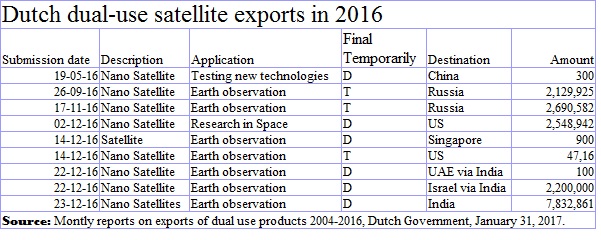
More and more small satellites are launched into space. A tenth of them has a clear military function. The Dutch Association for the Aerospace (NVR) in 2011 published a magazine dedicated to small satellites and the Dutch activities in this area. The Netherlands is a not insignificant party in this market.
Small satellites can be used for many purposes. The NVR writes:”Global forces can not do without satellites for a variety of purposes, such as communication, navigation, surveillance and intelligence. Command, guidance of weapons, weather forecasts and similar issues are dependent on information obtained through satellites. Military satellites increase the effectiveness of existing defence systems. Small satellites are becoming increasingly important because of many advantages, such as the possibility of rapid development of new satellites for specific purposes.”
Satellites have become indispensable for military deployment.
The Dutch government is one of the most transparent in Europe when it comes to providing information on the export and transit of strategic goods. Strategic goods are military and dual-use (civil and military, DU) goods.
The most recent overview of DU export gives a table of about 7,000 lines with exports for the period 2004-2016. Striking is the large number of satellite exports in 2016. Until 2016, only a few permits were issued for (weather) satellites and components (including optical technology and undefined components). The destinations were China, India and South Korea.
The significant increase in 2016 is mainly due to the export of nano satellites. These are sometimes not bigger than a milk carton, up to the size of a refrigerator and are launched into space with a rocket. The Netherlands Aerospace Centre (NLR) in Amsterdam is in charge of Dutch investigation into the application, but the Technical University Delft, the Netherlands Organisation for Applied Scientific Research (TNO) and smaller – but not insignificant – companies such as ISIS and Cosine are also involved in this development.
The market for satellites is divided into several segments, such as communications, surveillance, observation, scientific research, biological experiments, testing and demonstration of technology, science and navigation. Based on end-user, the following parties can be distinguished: government, society, industry, defence, energy, marine and transportation industries.
The bulk of the Dutch satellite exports in 2016 relates to nano satellites for observation. Both military, science and industry benefit from this. Observations can be used to improve the growing of crops, but also to identify opponents, possibly in preparation for an attack or a targeted elimination of people. The military or repressive applications of satellites might be controversial when exporting these strategic products.
The reputation of the countries (China, Russia, India, Israel, UAE) who purchase the Dutch satellites is not reassuring. It is known, for example from military considerations that Israel has invested heavily in observation satellites. The satellites of the extremely repressive Singapore among others intended for internal security and “for military purposes; to know what countries in the region are doing on land, air and sea.” The United Arab Emirates (UAE) are involved in the dirty war in Yemen. That earth observation could play a role in this war is indisputable.
The market for small satellites is growing rapidly and not all satellites have a military application. Most have a civil destination. Others have a dual function for both civilian and military applications. Unfortunately, it is unclear what will be the purpose the Dutch exports, because descriptions like ‘Earth observation’ and especially ‘Testing new technologies’ (China) and ‘Research in space’ (US) are extremely vague. Without the type name of the satellites, transparency is not very informative. And transparency is important to give society a possibility to assess on these growing exports which also have a military purpose.
MB feb 2017
.
